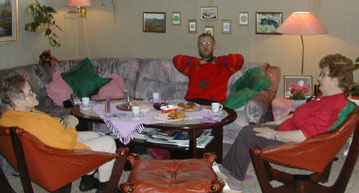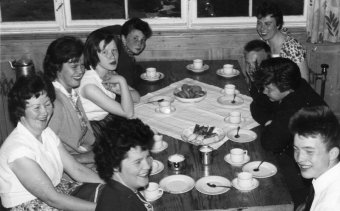 Åarjelh-saemien gielesne
Åarjelh-saemien gielesne
 Davvisámegillii
Davvisámegillii
 På norsk
På norsk
Article in the book Sami School History 1. Davvi Girji 2005.
Sofie Kappfjell and Ebba Westerfjell:
Boarding school better than village school
Interviewed and translated by Svein Lund
 Ebba Westfjell and Sofie Kappfjell are interviewed by Svein Lund, Majavatn 2003
(Photo: Basia Głowacka) |
In Majavatn southernmost in Nordland county live two sisters who both have been pupils at Havika Sami school, and they have both worked at the Sami school in Hattfjelldal.
But except from that they have very different experiences. Sofie Kappfjell is born in 1921 and went her whole primary school in Havika during the time 1928-35. 9 years younger Ebba Westerfjell went only one year at Havika before the war came. The rest of her school time she went to village school in Majavatn. We have talked with the two sisters together. |
Protested inside herself
- It was the Sami mission which run the school at Havika, tells Sofie.
- But there was no Sami language, no teachers spoke Sami. Neither did any of those who worked in the dormitory.
- When everything was in Norwegian, how much did you understand then?
- I understood some Norwegian when I started school, but there were others who were more clever. One could hear comments from the teachers as: "She is more clever, because she has more Norwegian at home." Then I thought why couldn't school be in Sami language. One somehow protested inside oneself. There were some children who really had problems because they knew very little Norwegian when they started school.
"Porrige Havika"
- The school had a rumour that it was very strict. How did you experience it?
- No, I did not feel that it was so strict. There had to be rules to follow. The pupils had their duties in the boarding school. We washed the desks, carried firewood and others. That indeed I liked, I did not feel that it was to much work. Somebody called the school "Porrige Havika", because we got so much porrige there. It was oat porrige with syrup. But I did like this porrige, and I still do. Later, when I have talked with others who have attended school at Havika, I have seen that we have experienced some things in a very different way. Others have complained very much things which I experienced positively. The worst was to be ill at the boarding school. Then I was lying in bed thinking of how fine it would have been to be at home.

| Majavatn has been a place where South-Samis have met. Among others has the Sami mission had their convention here twice a year. This picture is from 1930.
(Photo: Samenes venn /Rogstad: Streif i sør-samenes saga) |
Plagued at village school
Ebba got only one year at Havika.
- One went there as a sheep and did not understand so much. There were two pupils with whom I spoke Sami in the leisure time. Except that I don't remember much from that year. Then came the war, and then there was no more school at Havika until the war was over. The rest of my school time I went at Majavatn. There the school was in a room in the church, we called it the small hall. 1st - 3rd class went one week and 4th - 7th the next. It was terrible to go there. I was the only Sami child at the school all the time, from 2nd to 7th class. It was not so fun, I think it would have been better if there were more of us. I would not have lived those years again - never ever.
- What was the biggest problem - the teachers or the other pupils?
- It was the children, not the teachers which was the problem. One should not complain to the teachers. They were not so much out in the yard that they saw what was happening. I remember once we had had a test in Norwegian language. The teacher said to the class: "It is a great shame. Ebba speaks Sami at home and she is more clever in Norwegian than you." That he should never have said. That break afterwards became terrible. It was so bad that they never used my name, only words of abuse. What they said - no, it was so dirty words that I don't want to say them.
I complained at home. My father said that when some years have passed, probably the Norwegians will learn. I got the impression that the Norwegians were a little dumb. Then settled here a railway foreman with two daughters. One of them became my best friend, and then it changed and the worst mobbing ceased.
Housekeeper in Hattfjelldal
In 1958 was Sofie asked to come to Hattfjelldal to be a housekeeper at the Sami school.
- I had heard so much complains about the boarding schools, that I thought that I did not want to interfere with that. But I needed work, and as they asked me, I thought I might try for a year or two. It became more than 20 years, from 1958 and into the 80's. I have always liked children, but I have no education for working with them. But I had the housekeepers' school.
To be a housekeeper in boarding school was no work from 9 to 16 o'clock. It was almost all around the clock every day, and a lot of hard work. But I had a day off every second sunday! For me, who did not have a family of my own, the boarding school became my home in all these years. And I have had a lot of joy from the life and work there. But in the end I got such problems with my legs that I got disability welfare. Then I got built a house here at Majavatn.

| Ending of the school year 14.06.1962. Housekeeper Sofie Kappfjell to the left.
(Photo: Sigrid Bergli Sørnes) |
In Norwegian in the boarding school
- In the boarding school it was mainly spoken Norwegian. One could joke or talk a little in Sami with the Sami speaking children, but already then there were many of the children at school who only could speak Norwegian. If we should have used more Sami language, it would have been difficult for them. We neither got any wishes from the parents that we should speak Sami with the children.
Ebba has also worked at the Sami school in Hattfjelldal, in several periods in the 1970's and 80's. Then there had started to come some Sami language teaching into the school, but only 1-2 hours a week. The first time when the teaching of Sami started were Lars Børgefjell and Nils Kappfjell used as teachers. They had no education and no idea about how to present a language to the children. Sami language had then still no official status as a subject.
Own children at the boarding school
Ebba has brought up five children.
- When they should go to school I did not doubt that the best was to send them to the boarding school. From what I myself had experienced in the village school I thought that my children should not have to suffer like that.
Now a days there is not the same mobbing of Samis at it was in my school time. Now there is no longer school at Majavatn. It was closed down 5-6 years ago. The Sami children from Majavatn now go to school at Trofors, but a week now and then they are at the Sami school in Hattfjelldal where they learn Sami language and culture.
Future for South Sami language?
Already in the childhood of Sofie and Ebba the use of South-Sami was decreasing.
- Sami became a hidden language, says Sofie. It was talked in the family, but as soon as any Norwegian was present, we changed into Norwegian. But some times it was difficult to carry out. My mother talked only Sami in the family, and she was very talkative. And I just could not speak Norwegian to her. So then I had to speak Sami even if others were present.
The two sisters are not very optimistic about the future of the South-Sami language. I am afraid it will disappear, says Sofie. I have also been sceptical to introducing of South-Sami into school, but I couldn't be against it when it started.
One of those who started teaching of South-Sami language in school was a sister of Sofie and Ebba, Anna Jacobsen. She has been a teacher in South-Sami language and also written handbooks in the language. [1]
- She went southwards and married there, but then she came back, they tell. It was not much that she had as a help when she started. The only South-Sami dictionary was written in German (Lagerkrantz), but Anna learnt herself German so that she could read it.
It is good that we now have got a written language, that we did not have before. So that those who want may learn. And there are now in fact also others than South-Samis who are interested in our language. Here was even one who came from Germany and learned both South- and North-Sami.
[1] Den første boka på samisk ble trykt i Sverige i 1619. På norsk side ble det ikke trykt noe før i 1728.
[Anna Jacobsen died a few months after this interview. (Ed.)]
More articles from Sami School History 1
 Åarjelh-saemien gielesne
Åarjelh-saemien gielesne
 Davvisámegillii
Davvisámegillii
 På norsk
På norsk
 Åarjelh-saemien gielesne
Åarjelh-saemien gielesne
 Davvisámegillii
Davvisámegillii
 På norsk
På norsk

